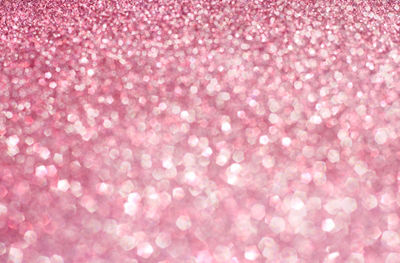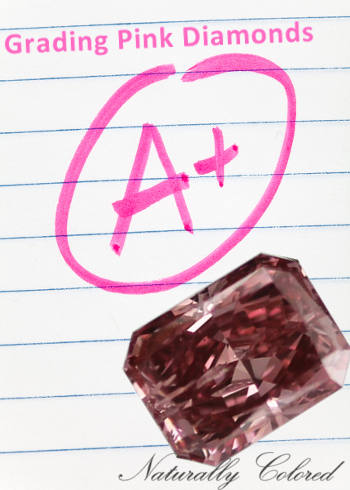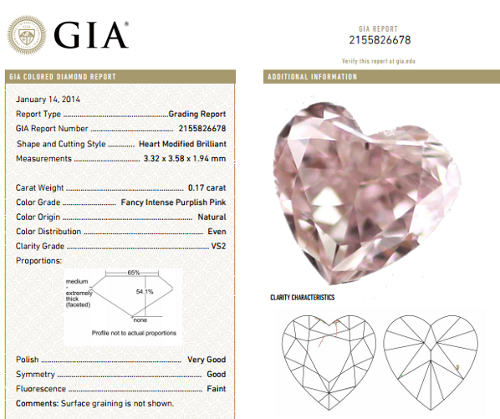Pink Diamonds Buying Guide
- Home /
- Diamond Buying Guides /
- Pink Diamonds Buying Guide
 Pink Diamonds Parcel
Pink Diamonds Parcel
Buying a diamond, any diamond, is a difficult task due to the high amounts involved, amounts that are higher in pink diamonds, and the literally microscopic changes in the diamond that may result in a serious price change.
But considering that most diamonds are bought for engagement rings, a very very emotional purchase, the task can be quite overwhelming.
But... it doesn't have to be!
The purpose of this guide is to assist in the purchasing process - what to look for? What to watch for (and what to watch from)? and even how to save lots of money.
But first thing first:
What are Pink Diamonds?
This is not the Pink Diamonds Wiki, we are not here to overwhelm you with facts that are unrelated to the purchase process (though I personally believe there is no such thing as too much information). However, there are some basic facts that will help you in understanding the rest of the guide and eventually become a smarter more educated buyer…
Pink Diamonds belong to the niche of colored diamonds. Diamonds, that unlike "regular" colorless diamonds, come in a variety of colors, of hues.
These colors include the relatively commonly known brown diamonds & yellow diamonds but also rarer colors such as orange, blue, purple, red, green and our beloved pink.
Pink diamonds are extremely rare. They are among the rarest colors of the niche. In fact, while what causes the colors of colored diamonds is known for all others, the pink color is still somewhat a mystery.
How Are Pink Diamonds Graded for Color?

When a colored diamond is graded for color, the color description is often a composition of two and maybe even three colors.
Pure pink diamonds exist, though are rarer than pinks with secondary colors. The color combinations you would encounter for pink diamonds are purple pink, brown pink, and orange pink.
You can figure the amount of the secondary color by the way it is described in the certificate. If the diamond is pink but only slightly brown it will be described as a brownish pink diamond whereas a diamond with stronger brown shade (but still mainly pink) would earn the color description of brown pink diamond.
Same goes for the other colors… purplish pink vs purple pink and orangy pink vs orange pink.
If we'll try to roughly put it into numbers, just for simplification, you can imagine a brownish pink diamond as 25% brown and 75% pink compared to a brown pink which is 40% brown and 60% pink. This is of course not an exact science but helps to get the idea.
As mentioned, it could even be a combination of three – for example a brownish orangy pink diamond, brownish purplish pink etc.
BUT HOLD ON – the colors of pink diamonds don't end there…
Last but definitely not least, there is another dimension for the colors. When colored diamonds (and with them pinks) are graded for color, they are also get graded for the its intensity. When you check the GIA certificate for the color description, you'll see that there is a prefix to the color. This prefix is the intensity.
Color intensities for pink diamonds range from faint, very light, light, fancy light, fancy, fancy intense, fancy deep and fancy vivid.
This means that the full description would be a fancy pink, fancy purplish pink. Fancy intense pink etc.
What to Check Before Buying a Pink Diamond?
When it comes to being a smart buyer there is one main thing to check prior to making a purchase of a pink diamond - check that the diamond is a GIA certified pink diamond. This clause of what to check is on purpose one of the firsts, the reason being that without a GIA certificate, you don't really know what you're getting and all the rest are irrelevant.
 GIA Certified Natural Fancy Intense Purplish Pink Diamond
GIA Certified Natural Fancy Intense Purplish Pink Diamond
Also note that it is not a mistake that I write GIA certificate and not a gemological certificate… GIA is world renown for being extremely strict and very consistent. But you don't need to trust my word for it… just Google Pink Diamonds and see that when a company has on display pink diamonds with GIA certificate and next to it a pink diamond with IGI certificate then always the price of the IGI certificated diamond would be less!
Why? Because what the IGI (random example) would maybe define as a fancy pink diamond may "just" be a fancy light pink in the eyes of the GIA or maybe have a brownish tint (i.e. fancy brownish pink) which will reduce its price dramatically.
How the Prices of Pink Diamonds are Set?
Years ago the GIA has invented the 4C's system for grading and evaluating a diamond. These are Carat, Color, Clarity and Cut. While there are MANY additional attributes that can seriously affect the diamond's price and value - these are the main 4 that can give you a general picture and they live in some sort of equilibrium.
Just for proportions, a colorless diamond with strong fluorescence (which is not even part of the 4 C's) will be easily valued 15%-20% less than a similar without fluorescence.
However, the GIA invented the 4C's mainly for colorless diamonds.
In colored diamonds the main emphasis is given to the color. A pure vivid pink weighing 1 carat will cost many times more than a very nice fancy pink weighing 1 carat (or even 2 carats for that matter).
There is no formula saying how much an intense pink would cost more than a fancy or a faint but you should know that the prices go up with the intensity of the color. And in some cases, as we get closer to the strongest intensities, the increase is not linear but rather exponential (in multiplies).
To make it even more complex, it is even harder to evaluate diamonds with secondary color:
How does the secondary color affect the prices of pink diamonds?
It depends… If the secondary color is rarer then it pushes the price up.
Will show an example on a brown diamond since it is very obvious being the most common and cheapest color… A reddish brown diamond (a brown diamond with secondary red tone) is MUCH more valuable than a pure brown. Same goes for pinkish brown vs brown. But this logic can also be implemented between pinkish brown vs reddish brown. Red is more rare than pink and reddish brown is more valuable (and rare) than pinkish brown hence more valuable.
But every coin has two sides… and diamonds with an inferior secondary color are reduced in price. A pink diamond with a secondary tone of brown is much cheaper than a pure pink…
Up till now we've discussed how color affects the prices of pink diamonds. The other 3 C's are relatively similar to colorless diamonds but with slight differences so we'll cover them shortly:
Carat -
Bigger is better and more expensive. But in diamonds bigger is actually heavier. Diamond prices are set per carat and the price per carat is higher as the weight goes up.
This means that two half a carat diamonds would cost much less than one diamond weighing 1 carat.
In mathematical terms: 2 * (0.50ct * $XXX) < 1.00ct * $YYY
Clarity -
Clarity takes a big role in the value of a diamond. The grading is the same as in regular diamonds: FL, IF, VVS1, VVS2, VS1, VS2, SI1, SI2, I1, I2 (learn more about clarity).
Price differences between VVS1 & VVS2 are relatively minor and same goes between VS1 & VS2. However, the price difference between vvs diamonds and vs is very significant.
With that said, an si1 is very different from si2 and here you need to make sure that the diamond is eye clean.
There is nothing wrong in buying an I clarity diamond, in fact sometimes the color is so mesmerizing that the clarity won't bother you and a similar colored diamond with higher clarity is out of your reach. BUT, if it is a low clarity diamond make sure you pay for it as a low clarity diamond.
Cut & Shape -
Cut and Shape are NOT the same thing though often considered the same… Cut refers to quality of the cut, how much brilliance the diamond possesses and how it reflects the light. In white diamonds it is so important that professionals often consider it as the most important C - after all, what good is there is a high color / high clarity diamond if it is completely dull? Makes sense!
BUT (another but…), in colored diamonds that is not the case. Colored diamonds are not cut for "best brilliance and sparkle" but rather for "best color".
This often means wide girdles, deep diamonds and various other "tricks" that master polishers use. So you shouldn't look too much on the cut grading as simply the appeal of the diamond. With that said, be warned of poorly cut diamonds. You don't need to settle for poor symmetry and bad polish.
When it comes to shapes, general rule of thumb is that round colored diamonds are more expensive. But you won't find too many of those. The round brilliant shape is ideal for white diamonds and the way they distribute the light causes them to appear whiter. Whiter in colored diamonds means paler – weaker color. There is a saying that a round colored diamond would have gotten a one degree stronger intensity if was cut as cushion / radiant etc. Meaning that a round fancy yellow would have probably gotten intense yellow in cushion - a more valuable alternative to the manufacturer hence this is what he'll do.
Is There Such a Thing Cheap Pink Diamond?
YES! & NO...
Yes there are cheap pink diamonds but not cheap natural pink diamonds…
Diamond Education
There are things like lab grown diamonds and color enhanced diamonds etc. however they are all considered treated, man-made diamonds. These are relatively cheap.
Color enhanced diamonds are diamonds that using some sort of treatment had their color manipulated and altered to be pink. As such they are neither rare nor valuable and in the eyes of many members of the trade are not considered that different than zirconia - and their color is different than natural pink diamonds, has a different appeal to it.
Man-made or in their other name lab grown diamonds are diamonds that as can be understood were grown in a lab simulating the earth's conditions that are needed to create a diamond.
Not surprisingly the popularity of treated colored diamonds (of both kinds) has increased with the great increase in popularity of natural colored diamonds. Another factor that "helped" triggered these treated diamonds is the rise in prices of natural colored diamonds that caused a wave of counterfeits on one hand and a need for a cheaper solution, a replica…
These are additional reasons why you need to make sure to by a certificated pink diamond to make sure that the color's origin is natural.
BUT… you can still ask the following:
How to Buy a Cheaper More Affordable Pink Diamond?
This you can definitely do - "Be a Smart Buyer"! After you read all the above you can easily use weak spots of the pricing methodology of pink diamonds to your behalf.
There are general tips for saving money on diamonds that always work, on any diamond, including buying below a weight class (i.e. 0.90 carat diamond instead of 1.00 carat diamond), not to discriminate lower clarity diamonds but rather think of the location of the inclusion and maybe conceal it with smart setting etc. Since pink diamonds are so rare any of these tips has a more dramatic effect on the price.
But on top of all of these the best way to save money on a pink is to play with the color!
As mentioned above color is the most important factor when it comes to the pricing of natural colored diamonds and especially in rare colors such as pink colored diamonds.
So… if you want a pink diamond and would like to dramatically reduce its price you can:
- Use rose gold setting to intensify the color thus settling for a bit lighter pink color (cheaper pink diamond).
- Reduce the size of the main pink stone and use a halo of melee diamonds. The contrast may help increase the pink color and the halo will make the entire sparkle from the ring look more impressive and bigger. Another (bit pricier option) is to use melee pink diamonds to create the halo thus the pink sparkle will make the main diamond look bigger.
- Settle on the color. Consider brown / brownish pink and orangy pink color diamonds that are much cheaper than pure pink and purple pink.
- Light colored diamonds are magnificent. Consider going for a fancy light or even less (not fancy and especially not intense). You'll still get that personalized touch and romantic pink tint for less than half the price.
Think you are ready buying your first pink diamond?
* Important note about diamond prices: Diamonds prices and especially colored diamonds prices cannot be calculated like a mathematical formula. There is no one right answer. The explanations above are in order to give you some tools and basic knowledge to (at least) watch out for yourself. In some of the cases, I used basic logic to simplify and explain complex subjects. At the end, each diamond is unique and different and needs to be valued on its own.
